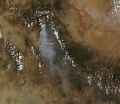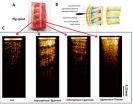(Press-News.org) This news release is available in French.
Choosing what is best is not always simple. Should one choose a small, certain reward, or take risks and try to get a larger reward? New research by Stan Floresco, from the Brain Research Centre at the University of British Columbia sheds light on the brain circuits that interact to help us decide the best strategy to adopt in changing circumstances. These results were presented at the 8th annual Canadian Neuroscience Meeting, taking place May 25-28 2014 in Montreal, Canada.
The studies of Dr. Floresco and his team used rats to show that areas deep inside the brain promote a more visceral bias towards large, but uncertain rewards, while brain regions located in the frontal lobes (which regulate higher order functions such as reasoning and planning), regulate and temper these urges when circumstances show the riskier option may be unlikely to yield reward. "It seems that the more primitive regions of the brain drive impulses to pursue larger rewards, but the frontal lobes take a longer view of the situation and put the brakes on these urges in situations when larger rewards may not be the most profitable ones in the long term", explains Dr. Floresco.
In another study, Dr. Floresco revealed that the activity of dopamine neurons seem to provide the brain with short-term updates of the outcomes of recent decisions that can influence the direction of subsequent ones. "Dopamine neurons show brief increases or decreases in activity when rewards are either received or not. However, we showed that if we turned these neurons off after a rewarded choice, or turned them on after a non-rewarded one, we could, in essence, remote control the decision making of these animals, making them behave as if they did not receive a reward (that they actually did) or vice versa", says Dr. Floresco.
Dr. Floresco also recently published an important paper highlighting the important and until recently underestimated role of another brain region, called the lateral habenula, in decision making. "An emerging view was that this brain region was primarily involved in signalling when something bad occured. Yet, our results show that its function is much more complex. When we shut down neural activity within this region, animals show random patterns of decision making, suggesting that this region plays a key role in promoting decision biases in one direction or another."
These results show the dynamic competition that exists between signals coming from different brain regions. The integration of these signals requires cognitive flexibility, which is the ability to react differently, update behavior and make appropriate choices in response to changes in one's environment.
Understanding how these signals are transmitted and act in the normal brain can help explain many neuropsychiatric conditions in which this signalling is defective. Schizophrenia is associated with abnormal activity in many of the same brain regions involved in efficient decision making. Delusions associated with schizophrenia can stem from associating strong emotional response to an innocuous situation. Not associating the right affective importance to pleasurable or aversive stimuli can result in inability to feel positive emotions like pleasure and to feel desire, which is one of the hallmarks of depression. Drug addiction can also be considered as a disease of decision making. «By clarifying the mechanisms through which different brain circuits interact to guide normal decision making, these studies may provide important insight into the brain dysfunction that may occur in these different disorders», concludes Dr. Floresco.
INFORMATION:
About the Canadian Association for Neuroscience:
The Canadian Association for Neuroscience is the largest association dedicated to the promotion of all fields of neuroscience research in Canada. The association has been organizing a yearly annual meeting since 2007. Learn more about our meeting at: http://www.can-acn.org/meeting2014
Making the right choices in changing circumstances: Cognitive flexibility in the brain
Multiple brain regions interact and compete to inform decision-making
2014-05-27
ELSE PRESS RELEASES FROM THIS DATE:
Scientists develop new hybrid energy transfer system
2014-05-27
Scientists from the University of Southampton, in collaboration with the Universities of Sheffield and Crete, have developed a new hybrid energy transfer system, which mimics the processes responsible for photosynthesis.
From photosynthesis to respiration, the processes of light absorption and its transfer into energy represent elementary and essential reactions that occur in any biological living system.
This energy transfer is known as Forster Resonance Energy Transfer (FRET), a radiationless transmission of energy that occurs on the nanometer scale from a donor molecule ...
Google Glass adaptation opens the universe to deaf students
2014-05-27
Ordinarily, deaf students are left in the dark when they visit a planetarium.
With the lights off, they can't see the ASL interpreter who narrates their tour of outer space. With the lights on, they can't see the constellations of stars projected overhead.
That's why a group at Brigham Young University launched the "Signglasses" project. Professor Mike Jones and his students have developed a system to project the sign language narration onto several types of glasses – including Google Glass.
The project is personal for Tyler Foulger and a few other student researchers ...
May 27 update on Slide Fire, Arizona
2014-05-27
The winds have shifted and the Slide Fire smoke that once hung heavy and gray over Flagstaff is now covering the city of Sedona in Arizona. Over 20,000 acres have burned in the Coconino Forest in Arizona. Inciweb.org reports that during Memorial Day crews completed the final perimeter burnout around the fire. This perimeter created by the fire crews is approximately 40 miles of line to form a containment perimeter around the fire. The fire is considered 35 percent contained at this point.
Today (Tuesday May 27) crews will work on holding the containment line along ...
Agricultural fires light up central Africa
2014-05-27
It is currently the dry season in the Democratic Republic of the Congo and the Moderate Resolution Imaging Spectroradiometer (MODIS) on NASA's Aqua satellite captured this image on May 24, 2014. MODIS detected hundreds of active fires (location marked in red) in the Democratic Republic of the Congo and northeastern Angola, a sign that the agricultural burning season is underway.
Agriculture is responsible for more than half of the products produced by the Democratic Republic of the Congo, and fire is a central feature in agriculture across most of Africa. Places where ...
UCI researchers identify new functional roles on cell surfaces for estrogen
2014-05-27
Irvine, Calif., May 27, 2014 — A discovery by UC Irvine endocrinologists about the importance of cell surface receptors for estrogen has the potential to change how researchers view the hormone's role in normal organ development and function.
To date, scientists in the field focused on receptors in the cell's nucleus as the primary site for estrogen's effect on gene activity and organ development and function. There has been acknowledgement of similar estrogen receptors outside of the nucleus but much debate as to whether they are important.
To investigate this, Dr. ...
New method discovered to protect against chemical weapons
2014-05-27
CORVALLIS, Ore. – Researchers at Oregon State University have discovered that some compounds called polyoxoniobates can degrade and decontaminate nerve agents such as the deadly sarin gas, and have other characteristics that may make them ideal for protective suits, masks or other clothing.
The use of polyoxoniobates for this purpose had never before been demonstrated, scientists said, and the discovery could have important implications for both military and civilian protection. A United Nations report last year concluded that sarin gas was used in the conflict in Syria.
The ...
Moving 'natural capital' from metaphor to reality
2014-05-27
Economists have long touted the importance of quantifying nature's value — from the natural treatment of pollution by wetlands to the carbon storage capacity of forests — and including it in measures of national wealth.
But so far, achieving an actual measurable value for this "natural capital" has remained elusive, says Eli Fenichel, an assistant professor of bioeconomics and ecosystems management at the Yale School of Forestry & Environmental Studies.
In a new paper, Fenichel and co-author Joshua Abbott of Arizona State University report developing an approach to ...
Eastern Pacific season off with a bang: Amanda is first major hurricane
2014-05-27
The first tropical cyclone of the Eastern Pacific hurricane season grew into a major hurricane as Hurricane Amanda reached Category 4 status on the Saffir-Simpson scale over the Memorial Day holiday weekend. NASA and NOAA satellites watched as Amanda developed an eye while strengthening.
Fortunately, Amanda is far enough away from coastal Mexico that no watches or warnings are in effect today, May 27.
On Sunday, May 25, Amanda strengthened into the first Major Hurricane in the Eastern Pacific Ocean. Maximum sustained winds were near 155 mph (250 kph). Amanda was centered ...
Precision-guided epidurals and better blood monitors
2014-05-27
WASHINGTON, May 27, 2014—The march of modern medicine is often driven by revolutions in medical imaging. When technology advances, doctors are better able to peer deeply into human tissues, and thus able to detect, diagnose and treat human diseases more effectively.
Now, researchers have taken an established imaging technology called "optical coherence tomography," or OCT, and integrated it with other instruments to bring about the next revolution in imaging by helping doctors provide safer, less painful and more effective care for women in labor and people with diabetic ...
Update on Funny River Fire, southern Alaska
2014-05-27
NASA's Terra satellite passed over the central Alaska and the Moderate Resolution Imaging Spectroradiometer (MODIS) instrument that flies aboard captured an image of smoke and hot spots from the Funny River Fire in southern Alaska on May 26 at 21:45 UTC (5:45 p.m. EDT). The heat from the fire appears red in the imagery and the smoke appears light brown.
On May 26 at 9:30 a.m. local time, the Alaska Interagency Incident Management Type 2 Team reported on the status of the fire through the multi-agency Incident Information System known as Inciweb. At that time the fire ...
LAST 30 PRESS RELEASES:
The impact of family dynamics on eating behaviour – how going home for Christmas can change how you eat
Tracing the quick synthesis of an industrially important catalyst
New software sheds light on cancer’s hidden genetic networks
UT Health San Antonio awarded $3 million in CPRIT grants to bolster cancer research and prevention efforts in South Texas
Third symposium spotlights global challenge of new contaminants in China’s fight against pollution
From straw to soil harmony: International team reveals how biochar supercharges carbon-smart farming
Myeloma: How AI is redrawing the map of cancer care
Manhattan E. Charurat, Ph.D., MHS invested as the Homer and Martha Gudelsky Distinguished Professor in Medicine at the University of Maryland School of Medicine
Insilico Medicine’s Pharma.AI Q4 Winter Launch Recap: Revolutionizing drug discovery with cutting-edge AI innovations, accelerating the path to pharmaceutical superintelligence
Nanoplastics have diet-dependent impacts on digestive system health
Brain neuron death occurs throughout life and increases with age, a natural human protein drug may halt neuron death in Alzheimer’s disease
SPIE and CLP announce the recipients of the 2025 Advanced Photonics Young Innovator Award
Lessons from the Caldor Fire’s Christmas Valley ‘Miracle’
Ant societies rose by trading individual protection for collective power
Research reveals how ancient viral DNA shapes early embryonic development
A molecular gatekeeper that controls protein synthesis
New ‘cloaking device’ concept to shield sensitive tech from magnetic fields
Researchers show impact of mountain building and climate change on alpine biodiversity
Study models the transition from Neanderthals to modern humans in Europe
University of Phoenix College of Doctoral Studies releases white paper on AI-driven skilling to reduce burnout and restore worker autonomy
AIs fail at the game of visual “telephone”
The levers for a sustainable food system
Potential changes in US homelessness by ending federal support for housing first programs
Vulnerability of large language models to prompt injection when providing medical advice
Researchers develop new system for high-energy-density, long-life, multi-electron transfer bromine-based flow batteries
Ending federal support for housing first programs could increase U.S. homelessness by 5% in one year, new JAMA study finds
New research uncovers molecular ‘safety switch’ shielding cancers from immune attack
Bacteria resisting viral infection can still sink carbon to ocean floor
Younger biological age may increase depression risk in older women during COVID-19
Bharat Innovates 2026 National Basecamp Showcases India’s Most Promising Deep-Tech Ventures
[Press-News.org] Making the right choices in changing circumstances: Cognitive flexibility in the brainMultiple brain regions interact and compete to inform decision-making








